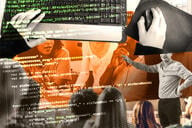You have /5 articles left.
Sign up for a free account or log in.
The fourth industrial revolution is upon us! It is unlike any previous cultural change we have confronted. Sure, the previous revolutions moved us from rural to urban environments; shifted our dependence on animals to machines; and even connected us digitally to each other in ways we had never imagined. Professor Klaus Schwab, founder and chairman of the World Economic Forum, says, “This fourth industrial revolution is, however, fundamentally different. It is characterized by a range of new technologies that are fusing the physical, digital and biological worlds, impacting all disciplines, economies and industries, and even challenging ideas about what it means to be human.”
The impact in the working world is profound. Overall in the U.S., the average number of years that an employee stayed with an employer as of last year was 4.2. In some fields it was higher, but in others, such as the leisure and hospitality field, it was just over two years. Note that those numbers account for years with an employer, not in a given job. So, a worker may have changed jobs within the same corporation or agency over that time. That means that workers are in a state of constant retraining and development to take on the new responsibilities of their changing jobs.
At stake for workers is continuing a livelihood that will provide for their needs and the needs of their families. The McKinsey Global Institute reports that more than 375 million jobs will be lost or changed in the coming decade: “Our scenarios suggest that by 2030, 75 million to 375 million workers (3 to 14 percent of the global workforce) will need to switch occupational categories. Moreover, all workers will need to adapt, as their occupations evolve alongside increasingly capable machines. Some of that adaptation will require higher educational attainment, or spending more time on activities that require social and emotional skills, creativity, high-level cognitive capabilities and other skills relatively hard to automate.”
For most people in this emerging fourth industrial revolution, professional development is not an option; it is a necessity. But that doesn’t mean it should be chore. In fact Mary Shindler, senior program manager on the learning and development team at LinkedIn, says, "Data is showing that team members who engage in learning are found to be happier and feel more satisfied in their careers. That's a significant benefit, both for the employee and the business. Learners who are engaged in their work are happy. Happy people do their best work. Imagine a workforce where employees are happy, engaged and doing the best work of their careers. That's what we're hoping to achieve with L&D."
Continuing professional development is not a once-every-four-years kind of experience. It is ongoing and incremental. Vivian Kloosterman, the founder of the Continuing Professional Development organization, writes, “Sometimes it is mandated by professional organizations or required by codes of conduct or codes of ethics. But at its core it is a personal responsibility of professionals to keep their knowledge and skills current so that they can deliver the high quality of service that safeguards the public and meets the expectations of customers and the requirements of their profession.”
We in higher education must take on the challenge of the emerging fourth industrial revolution to prepare learners for what has come and is yet to come in the workplace. Opportunities abound if we are prepared to meet the challenge in cooperation with employers and states. Delivery is, by necessity in most cases, online so that workers can continue their daytime duties while pursuing development on a schedule that fits their lives. It must be reliable, responsive and just in time to meet the needs as they emerge.
Are you working with colleagues and employers to identify needs and skills that will fuel the future? Is your college or university actively engaged in creating midcareer development courses and programs to advance your learners in their fields? How will the fourth industrial revolution change the mission and practice of your institution?

